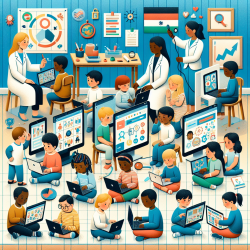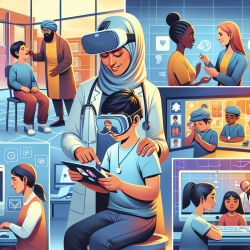Introduction
In the realm of speech-language pathology, understanding the genetic underpinnings of developmental disorders is crucial for creating effective interventions. The research article titled "MATR3 disruption in human and mouse associated with bicuspid aortic valve, aortic coarctation and patent ductus arteriosus" sheds light on the genetic disruptions that can lead to congenital heart defects and associated developmental delays, including speech and language impairments.
Understanding MATR3 and Its Implications
The MATR3 gene, which encodes the nuclear matrix protein Matrin 3, has been linked to several congenital heart defects such as bicuspid aortic valve (BAV), coarctation of the aorta (CoA), and patent ductus arteriosus (PDA). These defects are often accompanied by developmental delays, including speech and language impairments, which are of particular interest to speech-language pathologists.
Research indicates that disruptions in the MATR3 gene can lead to alterations in protein expression, affecting cardiac development and potentially contributing to developmental delays. Understanding these genetic factors allows practitioners to tailor their therapeutic approaches, addressing not only the symptoms but also the underlying causes of developmental delays.
Data-Driven Approaches in Speech-Language Pathology
For practitioners at TinyEYE, integrating genetic insights into therapy sessions can enhance outcomes for children with developmental delays. By considering the genetic factors contributing to a child's condition, therapists can develop more personalized and effective intervention strategies. This approach is supported by data-driven decision-making, which emphasizes the importance of using empirical evidence to guide clinical practices.
For example, if a child presents with speech delays and has a known MATR3 disruption, therapists might prioritize interventions that support neural crest development and cardiac function, in addition to traditional speech therapy techniques. This holistic approach can lead to more comprehensive care and improved outcomes.
Encouraging Further Research
While the current research provides valuable insights, it also highlights the need for further investigation into the role of MATR3 in developmental disorders. Practitioners are encouraged to stay informed about ongoing research and consider participating in studies that explore the genetic basis of speech and language impairments. By contributing to the body of knowledge, practitioners can help advance the field and improve therapeutic strategies for future generations.
Conclusion
Understanding the genetic factors that contribute to developmental delays is essential for speech-language pathologists seeking to provide the best possible care. The MATR3 research offers valuable insights that can inform therapeutic approaches, leading to better outcomes for children. By embracing data-driven decision-making and staying engaged with ongoing research, practitioners can continue to enhance their skills and make a positive impact on the lives of their clients.
To read the original research paper, please follow this link: MATR3 disruption in human and mouse associated with bicuspid aortic valve, aortic coarctation and patent ductus arteriosus.










